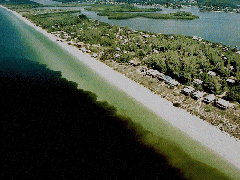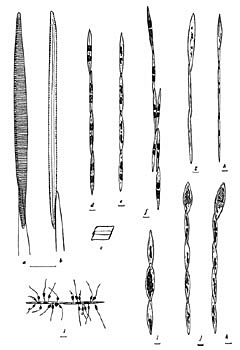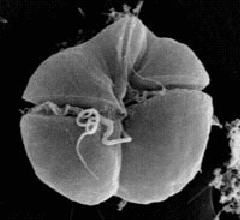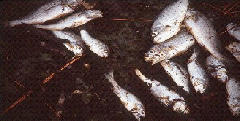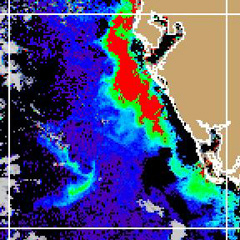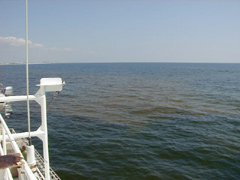|
|
Harmful algal blooms (HABs) occur when algae, simple plants that live in the sea and form the base of the food web, produce toxic or harmful effects on people, fish, shellfish, marine mammals and birds. HABs have been reported in almost every U.S. coastal state, and their occurrence may be on the rise. The problem is of national concern, and is being studied by NOAA’s National Ocean Service, because HABs can adversely affect not only the health of people and marine organisms, but also the "health" of local and regional economies.
The human illnesses caused by HABs, though rare, can be debilitating or even fatal. The person grows ill after consuming seafood that is tainted from the ingestion of biotoxin-producing algae. These syndromes include ciguatera fish poisoning and neurotoxic, diarrhetic, paralytic and amnesic shellfish poisoning.
Perhaps the best known HAB is the so-called “red tide” that occurs nearly every summer along Florida’s Gulf Coast, and that Spanish explorers first observed in the 16th century! The organism that causes the Florida red tide (which may not always appear red), a microscopic alga called Karenia brevis, produces a toxin that makes shellfish dangerous to eat. It also kills fish, and in some instances, dolphins and manatees. It may also make the surrounding air difficult to breathe due to aerosolized toxins. Scientists have been monitoring and studying the phenomenon for a number of years to determine how to detect and forecast the location of the blooms. The goal is to give communities advance warnings so they can adequately plan and deal with the adverse environmental and health affects associated with these red-tide events.
The Harmful Algal Bloom and Hypoxia Research and Control Act was signed into law on November 13, 1998, becoming P.L. 105-383 and reauthorized in December 2004 (P.L. 108-456). The Act recognized that many U.S. coastal areas suffer from HABs and hypoxia each year, threatening coastal ecosystems and endangering human health. To respond to these concerns, the Act calls for:(1) the establishment of an interagency task force on HABs and hypoxia (low dissolved oxygen); (2) a national assessment on HABs in coastal waters; (3) a national assessment on freshwater HABs; (4) a national assessment on hypoxia; (5) a report on prediction and response for HABs; and (6) a national scientific research, development, demonstration, and technology transfer plan for reducing impacts of HABs. The Oceans and Human Health Act was also passed, establishing intramural Centers of Excellence and providing funding for intramural and extramural research on HABs and other health problems in an ecosystems context. The Coastal Zone Management Act also authorizes HAB monitoring. As the federal agency largely responsible for overseeing the nation’s marine resources, NOAA is carefully studying what causes HABs and how they can be predicted and prevented. Within NOAA’s National Ocean Service (NOS), much of this work is conducted through its National Centers for Coastal Ocean Science (NCCOS), which maintains the Harmful Algal Bloom Web Site. This Web site provides information on HABs, including information on HAB ecology and forecasting and workshops and meetings, as well as news releases and related links.
The NCCOS Center for Coastal Monitoring and Assessment provides information on HAB identification and monitoring. It uses models, together with data from satellite sensors and field and instrument observations from research vessels, to develop the remote sensing methods necessary to monitor and forecast HABs. A collaboration between NCCOS and the NOAA Coastal Services Center produced a first-generation remote sensing tool to identify and predict the movement of HABs in the Gulf of Mexico. Bulletins containing this information are developed by integrating data from various ocean-observing systems, including imagery from commercial and government satellites supported by the NOAA CoastWatch Program; meteorological data from NOAA observing stations; and field data collected by state and university monitoring programs. The information is now being produced operationally by NOAA's Center for Operational Oceanographic Products and Services. These bulletins enable coastal resource managers to respond rapidly to conditions that may negatively impact coastal habitats and marine life in their areas.
Another CSCOR program is ECOHAB (Ecology and Oceanography of Harmful Algal Blooms), a multi-agency partnership between CSCOR and the National Science Foundation, U.S. Environmental Protection Agency, NASA and the Office of Naval Research. Through long-term regional studies and short-term targeted studies, ECOHAB seeks to produce new detection methods for HABs and their toxins, to understand the causes and dynamics of HABs, to develop forecasts of HAB formation, growth, transport, and toxicity, and to predict and reduce impacts on people and ecosystems. Scientists at the NCCOS Center for Coastal Environmental Health and Biomolecular Research (CCEHBR) have developed new in-the-field blood-sampling technology that can identify the presence of toxins in living animals. The development is significant because it may improve resource managers’ ability to predict the impact of a HAB during its initial stages. |
|
||||||||||||||||||||||||||||||||||
- NOS Program Offices
- Center for Operational Oceanographic Products and Services
- National Centers for Coastal Ocean Science
- NOAA Coastal Services Center
- National Geodetic Survey
- Office of Coast Survey
- Office of National Marine Sanctuaries
- Office of Ocean and Coastal Resource Management
- Office of Response and Restoration

Revised November 26, 2008
| Questions, Comments? Contact Us | Report
Error | Disclaimer | About
the Site | User Survey
National Oceanic and Atmospheric
Administration | U.S.
Department of Commerce | USA.gov
http://oceanservice.noaa.gov/topics/coasts/hab/welcome.html

